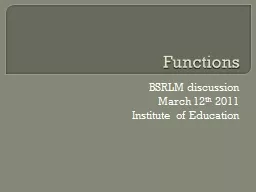

BSRLM discussion March 12 th 2011 Institute of Education Why equations graphs and functions Whats the same and whats different Equations A12bh v 2 u 2 2as y 2x5 3x 59 2x ID: 465658
Download Presentation The PPT/PDF document "Functions" is the property of its rightful owner. Permission is granted to download and print the materials on this web site for personal, non-commercial use only, and to display it on your personal computer provided you do not modify the materials and that you retain all copyright notices contained in the materials. By downloading content from our website, you accept the terms of this agreement.
Slide1
Functions
BSRLM discussion
March 12
th
2011
Institute of EducationSlide2
Why equations, graphs and functionsSlide3
What’s the same and what’s different?Slide4
Equations
A=1/2bh
v
2
- u
2 = 2as
y = 2x+5
3x - 5=9 - 2x Slide5
Nature of graphs
One variable
Two variables
More variables
Interval dataSlide6
Nature of functions
One-to-one or one-to-many mappings between sets
Input/output machines with algebraic workings
Input/output ‘black boxes’ such as trigonometric or exponential functions
Expressions to calculate y-values from given x-values
Relations between particular x-values and y-values
Relations between a domain of x-values and a range of y-values
Representations of relations between variables in ‘realistic’ situations
Graphical objects which depict particular values
Graphical objects which have particular characteristics
Graphical objects which can be transformed by scaling, translating and so on
Structures of variables defined by parameters and relations Slide7
What is met in primary school?Slide8
Equations (in primary)
unknown numbers in number sentences
situations like x + y = 6, or x – y = 4
use of formulae: areas of simple shapes; conversions of units.Slide9
Graphs (in primary)
pictorial representations
bar charts
trend lines
experimental data against time
discussed in terms of steepness, higher/lower distinctions, and zeroesscaling the vertical axis
scaling
the horizontal axis. Slide10
Functions (in primary)
term-to-term rules for simple sequences
one-to-one, many-to-one, and one-to-many mappings
qualitative relations between variables in realistic phenomenaSlide11
Problems in learning about functions
Discuss ...Slide12
Sidetracked by notation
f as a
label
f(y) and f(b) as different
functions
f(x) as the formula for a
function
f(3) means the function has value
3
f(
x+y
) = f(x) + f(y
)
f(y) is the
ordinate
f(x) = g(x) is an instruction to find an
unknown
f(x) is a
graph
f(x) means ‘f times x’Slide13
Yerushalmy’s
work (JRME year 8) students using graphing software
Car hire with a $100 cost per day and $5 cost per mile
f(n)= n. 100 + x * 5
f(n) +f(x) = n * 100 + x. 5
f(n, b) = (n . 100) + (b. 5)
(n .100) + (k.5) =f(n, k)
f(d, k) = n(d) . 100 + n(k) * 5Slide14
R
esearch findings re: equations (in relation to graphs and functions)
Methods which retain the notion of equality of expressions seem particularly powerful, and relate well to understanding the properties of functions.Slide15
Research re: graphing in relation to equations and graphs
Graphs and graphing both realistic and algebraic data: problems of conceptual understanding rather than technical problems.
Swan and colleagues: cognitive conflict
Ainley
, Pratt and colleagues: purpose, utility, meaning.Slide16
Research re: functions in relation to equations and graphs
Understanding, both in pure mathematics and as tools for modelling, takes many years to develop.
continuous and discrete;
with and without time in the x-axis;
smooth and non-smooth
calculable and non-calculable
do/do not depict the underlying relations in obvious waysSlide17
Consistent
use of multiple representation software over time can, with appropriate tasks and pedagogy, enable students to understand the concepts and properties associated with functions, and be able to use functions to model real and algebraic data.Slide18
a
nne.watson@education.ox.ac.uk